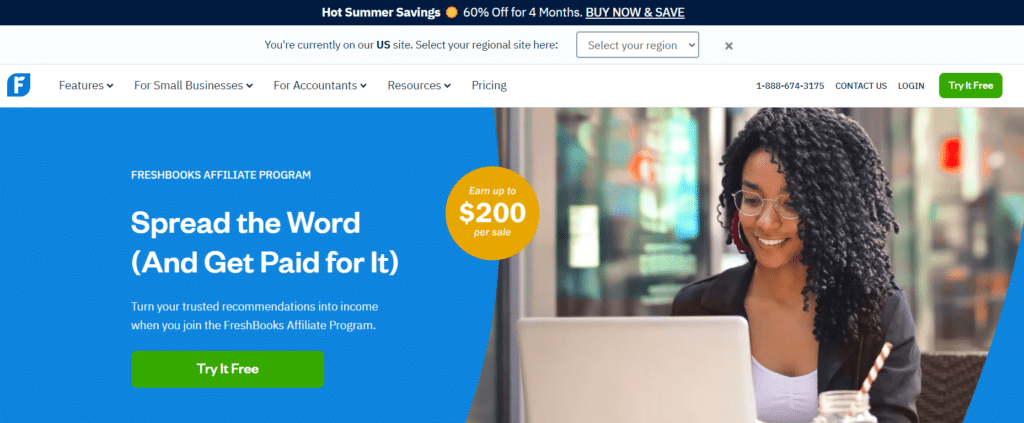By creating an affiliate marketing program, you can expand your reach to a wider audience without increasing your marketing budget dramatically.
With affiliates promoting your business for you, you’ll see higher conversion rates thanks to this amplified reach.
Just look at HP.
Thanks to its affiliates, the IT firm increased its revenue by 43%.
If you want to boost your revenue and widen your brand reach, read on to learn how to start an affiliate marketing program for your online shop.
Why Build an Affiliate Marketing Program?
Affiliates are third parties that act as intermediary salespeople for your brand.
Firstly, this helps to increase brand awareness. With affiliates promoting your products to their already-established audiences, you’re able to reach customers that you may not have been touching before.
Not only that, but affiliates can help you break into new niches and markets. While you may have been marketing your products to a particular segment, affiliates may find that your goods are suitable to promote to their audiences within different industries.
What’s more, affiliates work on a commission basis. This means that they market your products without any upfront cost. If an affiliate doesn’t manage to sell any of your products, you don’t have to pay them anything for their marketing efforts.
In this sense, affiliate programs can save you lots of money on marketing.
5 Steps to Building an Affiliate Program for your eCommerce Store
If you’re thinking of building an affiliate program to widen your reach and boost your conversion rates, follow these five steps.
1. Come up with a killer deal
To attract affiliates to your product, you need a deal that will convince them to do the initial work. After all, affiliates aren’t paid unless they make a sale.
For affiliates, there’s nothing worse than spending hours marketing a product only to receive a couple of dollars for your efforts. If you want affiliates to vouch for your brand, you need to entice them with a strong offer.
Plus, you’ll often compete with other brands trying to net affiliates. If you want affiliates to choose your product over competitors, you must stand out from the crowd.
Most affiliate deals offer commission. Make sure it’s a decent percentage. Nobody wants to promote your products only to make 2% on a sale.
One major tip is to adjust your percentage depending on the price of your product. If you’re selling big-ticket items that don’t sell very often, you must offer a higher percentage. If you’re selling smaller products that sell often, then you can offer a lower percentage.
Look at how Preply offers its tutors for English lessons a whopping $200 for bringing in new students.

You may also want to give the affiliate a discount code they can give their audience. This provides an added incentive for affiliates to choose your brand and a reason for their audience to convert.
The best affiliate programs also reward their affiliates. Most often, rewards come in the form of performance-related bonuses.
2. Set boundaries
For the sake of quality assurance, you need to create rules around your affiliate program. These boundaries not only keep affiliates on track, they prevent your marketing campaigns from overlapping.
Start by creating a list of dos and don’ts for your affiliates.
For example, you may want your affiliates to stick to certain wording or to keep off particular platforms.
This is especially important if you’re running your own marketing campaigns. Let’s say you post promotions in specific Facebook groups. You don’t want affiliates to also post in these groups, or you’re unnecessarily competing against each other.
It’s also wise to give affiliates an idea of your target audience. While affiliates can help you tap into new audiences, there may be particular profiles you’re keen to keep away from. Make this clear so that affiliates aren’t building your brand an unsavory reputation with the wrong crowd.
3. Create sales and marketing materials
If you’re relying on affiliates to help build your brand awareness, you need to help them promote your brand’s identity.
Sales and marketing materials can help promote your brand’s values while sticking to your branding themes.
Firstly, create sales enablement materials that teach your affiliates how to sell your brand. Include the benefits of your products, customer testimonials, and information on how you solve customer problems.
You’ll also need to include visual content that an affiliate can use to promote your products.
This form for marketing PEO companies is a good example of the type of interactive marketing you should aim to have your affiliates use:
Most U.S. affiliate sales come from bloggers, so you must provide some graphic content to help break up their text articles. Include product photos, promotional banners, logos, advertising images, videos, and more. If you’re working with many products, it may make sense to invest in a photo management platform to keep everything organized.
Don’t skimp when it comes to creating this content. After all, the right image can boost your conversion rate by 161%.
4. Pick a technology
You’ll need a way to track affiliate sales and dish out commissions. Luckily, there are plenty of different technologies that can help you do this.
Most companies choose to launch their program through an affiliate marketing platform, like Shareasale or Awin.
These platforms offer comprehensive sales tracking dashboards with extensive reporting features to provide you with user insights. They’ll also pay out commissions automatically to save you a job.
Plus, these platforms make it easy for affiliates to find you. Your brand will be added to the library so affiliates can locate you when searching for relevant companies to promote.
Look at Credit Saint, for instance.
The credit repair company uses Shareasale to attract affiliates. When an affiliate searches for ‘credit repair’ firms, Credit Saint comes up in the search, immediately showing the affiliate what deal they have on offer.

This makes it easy for affiliates like Simple Money Life to create a review of Credit Saint and add affiliate links.
If you’d rather run an in-house affiliate program, you’ll need affiliate tracking software like AnyTrack or Tapfiliate.
These platforms will help you track affiliates and payout commissions. They will also give you the functionality to create personalized affiliate links.
You can use these platforms to create and share promotional materials as well.
5. Source high-quality affiliates
Not all affiliates are created equal. While lots of people may sign up to promote your brand, not all of them will generate the sales you’re looking for.
Since you need 352 impressions to make one sale, you’ll need top-shelf affiliates with high monthly traffic volumes.
It might be worth approaching known influencers in your industry over and above the affiliates you net from your platforms. That way, you know they have decent-sized audiences to promote your products to. You can even get backlinks from the sites of these top-notch affiliate influencers.
Conclusion
An affiliate program will help you reach new audiences and boost conversions without significantly increasing your marketing budget.
Just remember that you need a great deal to outshine competitors and convince affiliates to choose your brand.
If you need more advice on techniques to improve your conversion rate, get in contact with the experts at FigPii today.
Author Bio: Emmy Jenkins is a specialist technical writer with vast experience in SaaS, business, and marketing. When she’s not building better systems in her veggie garden, she’s obsessing over how her readers can build better systems in their businesses and personal lives.

